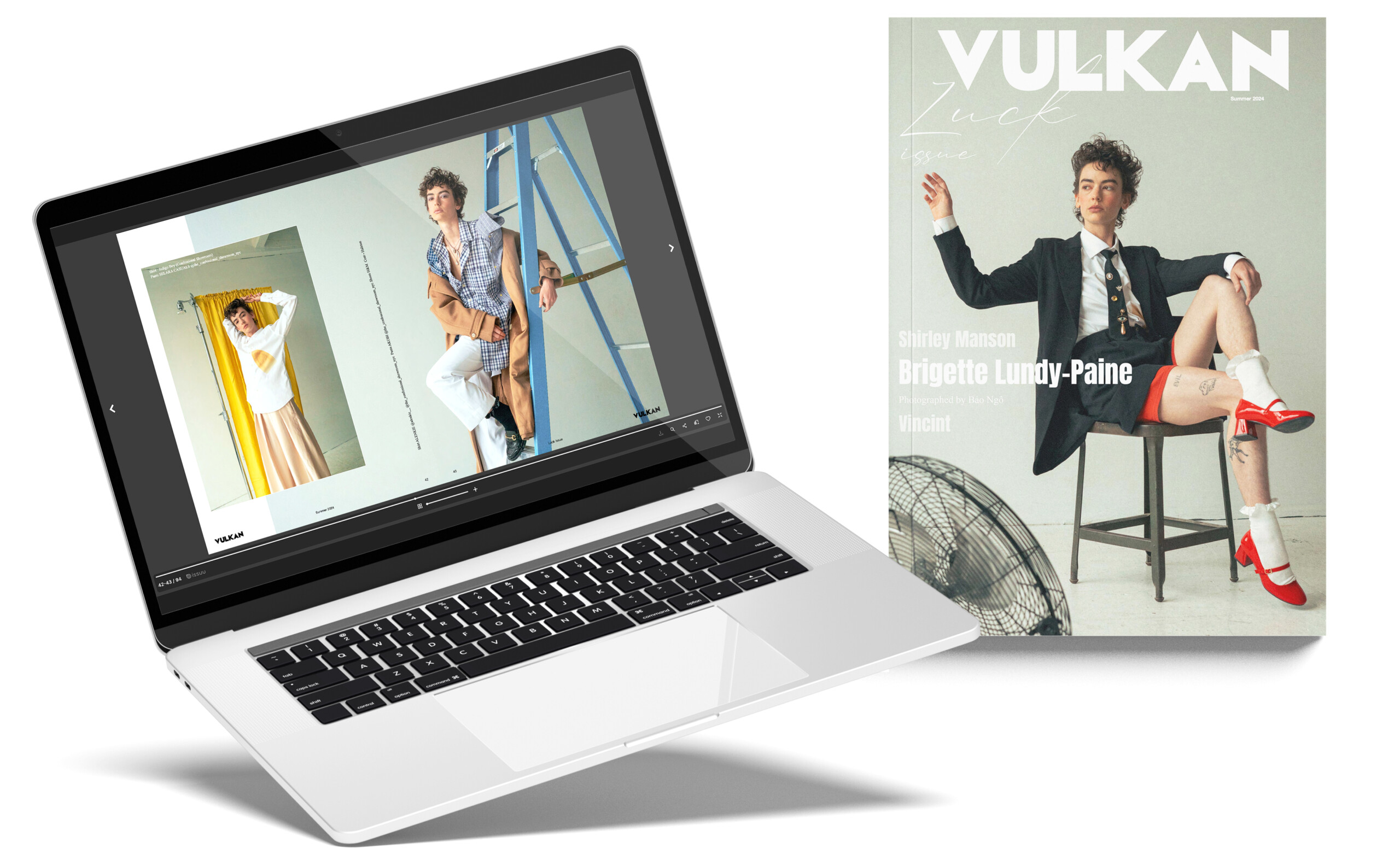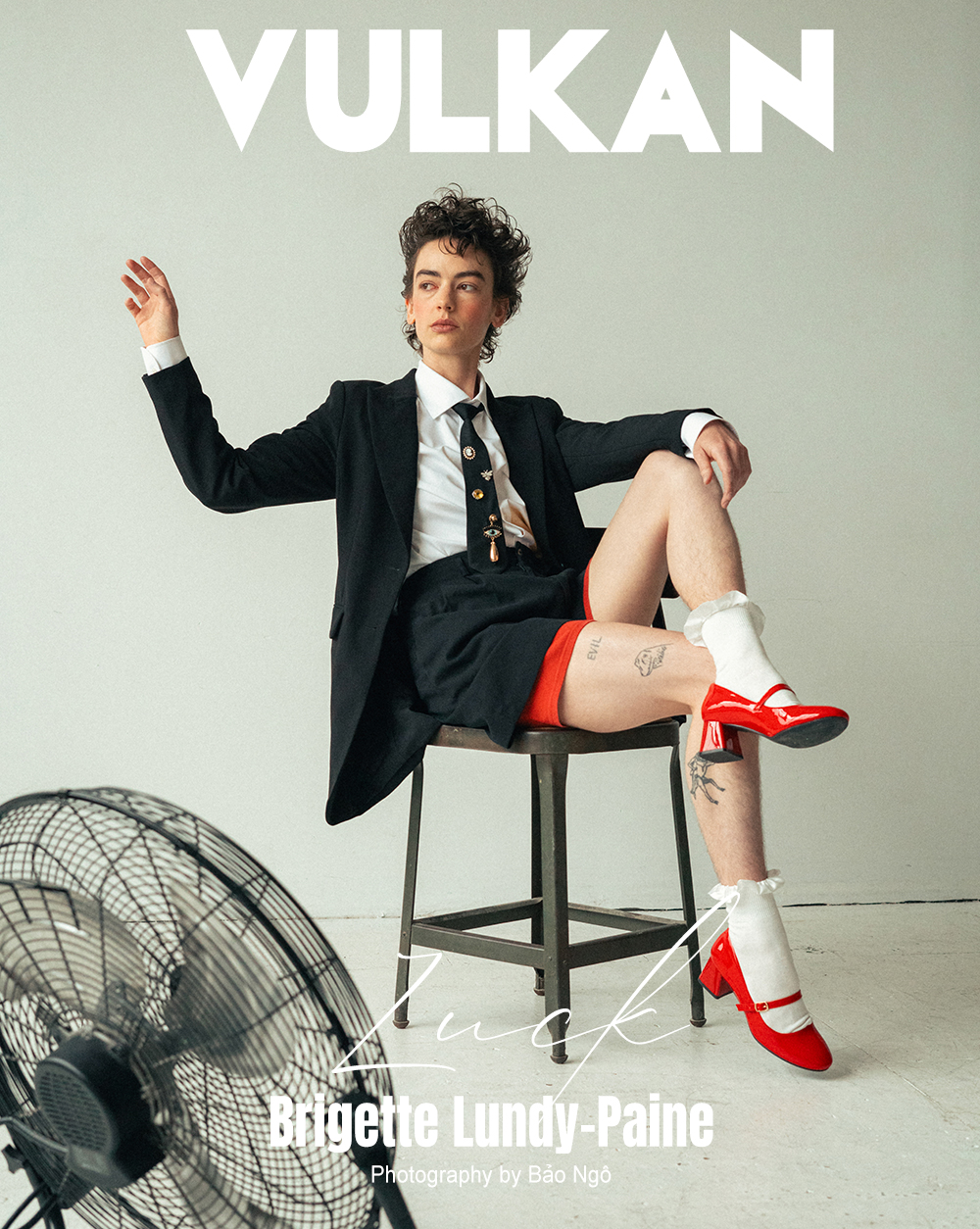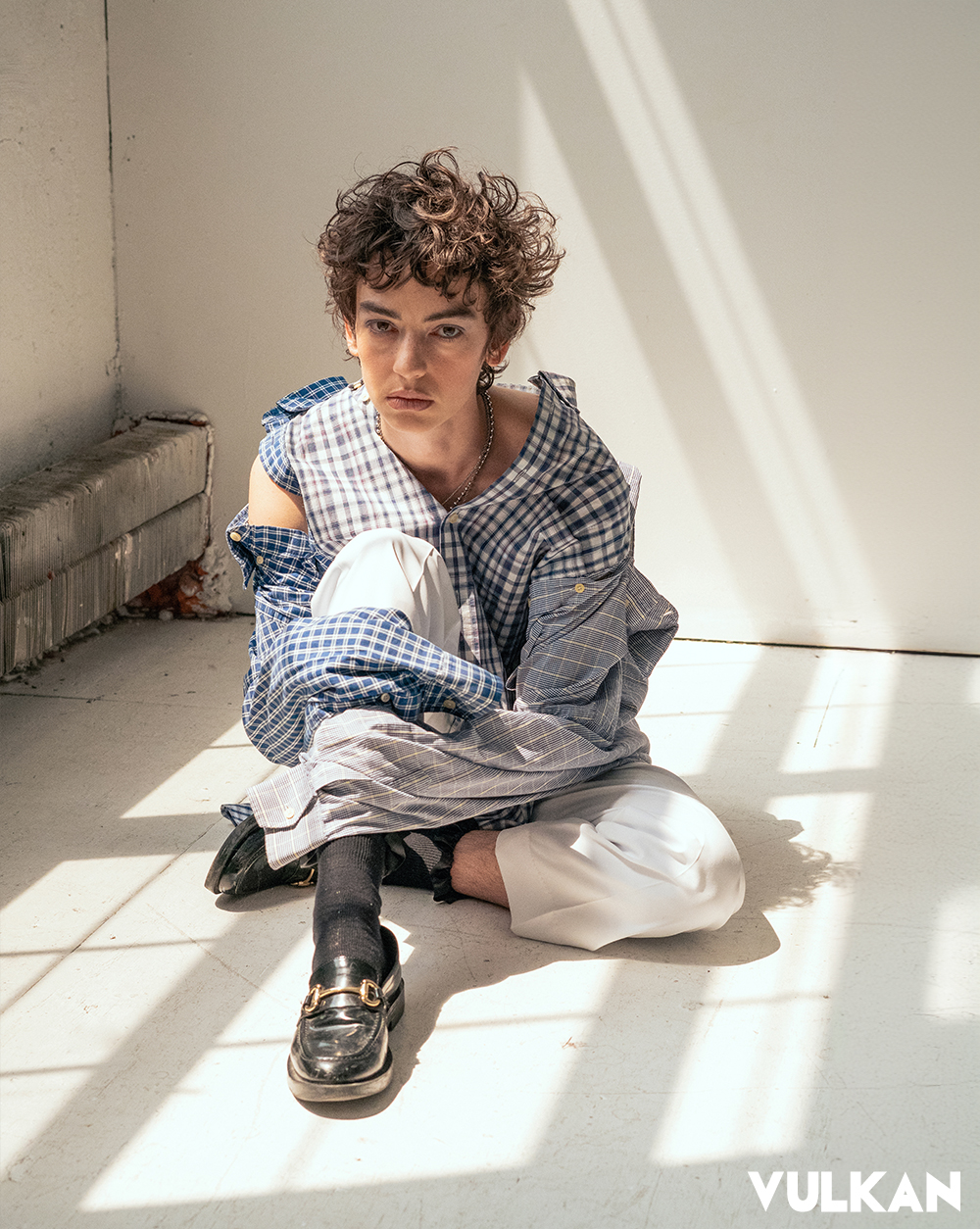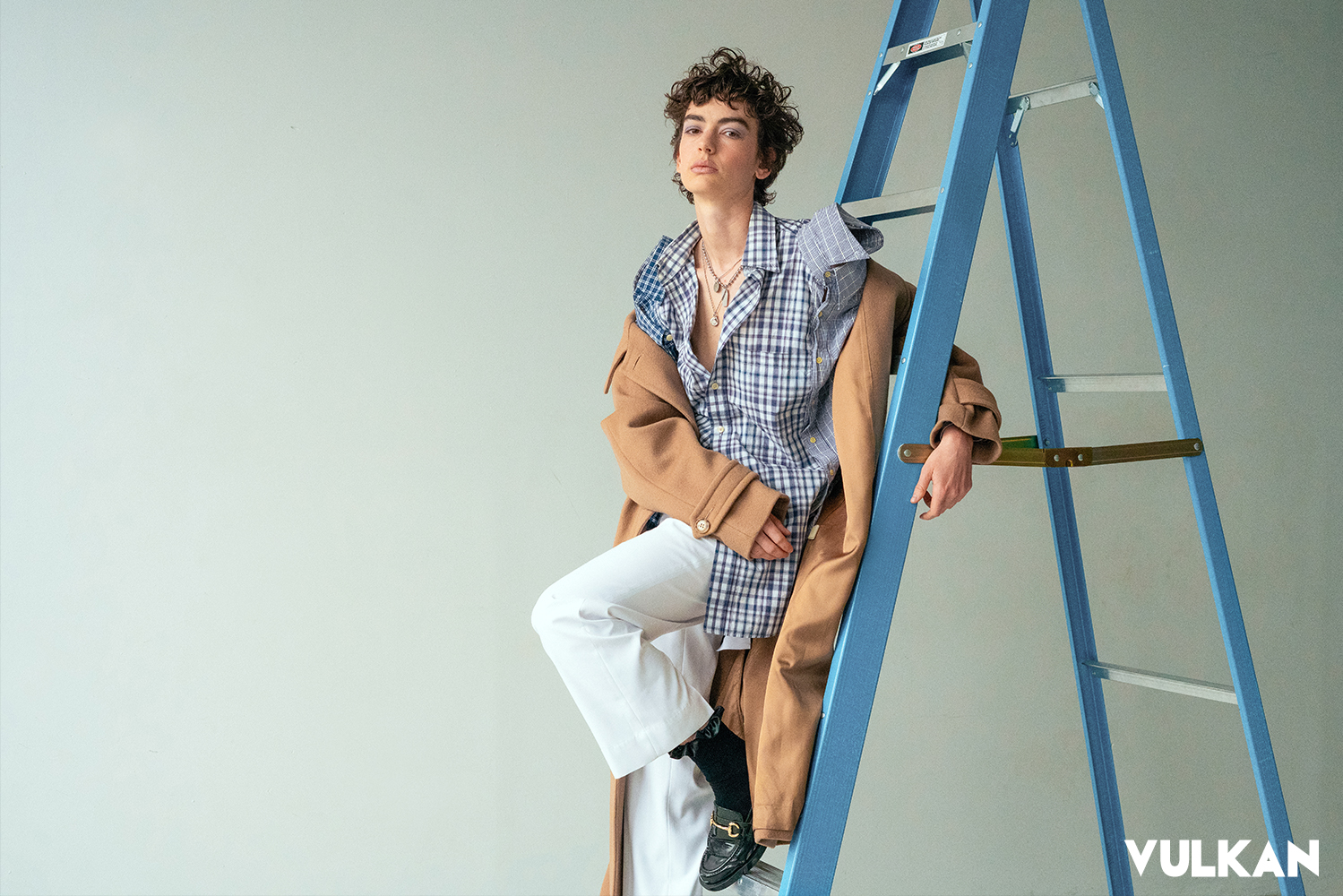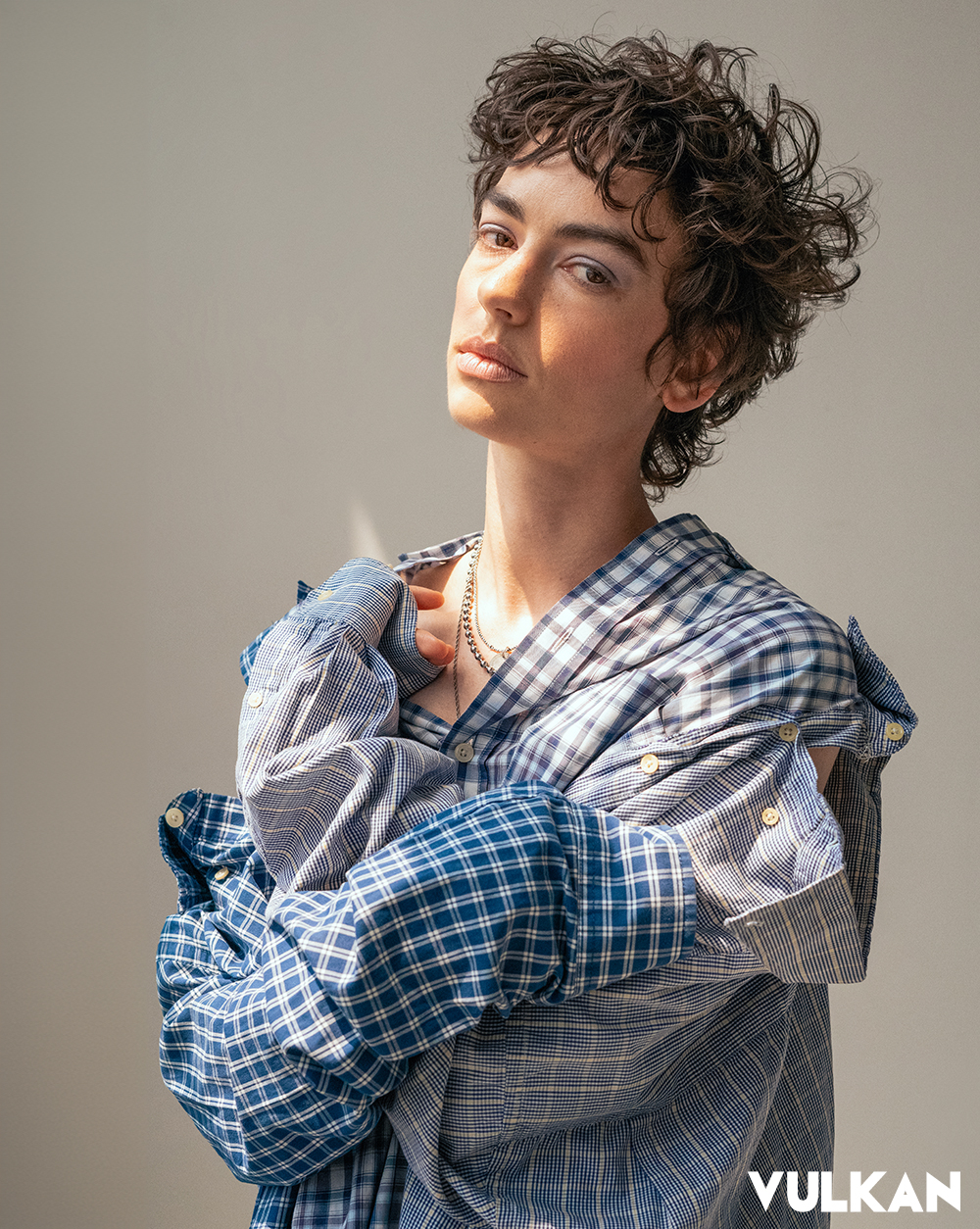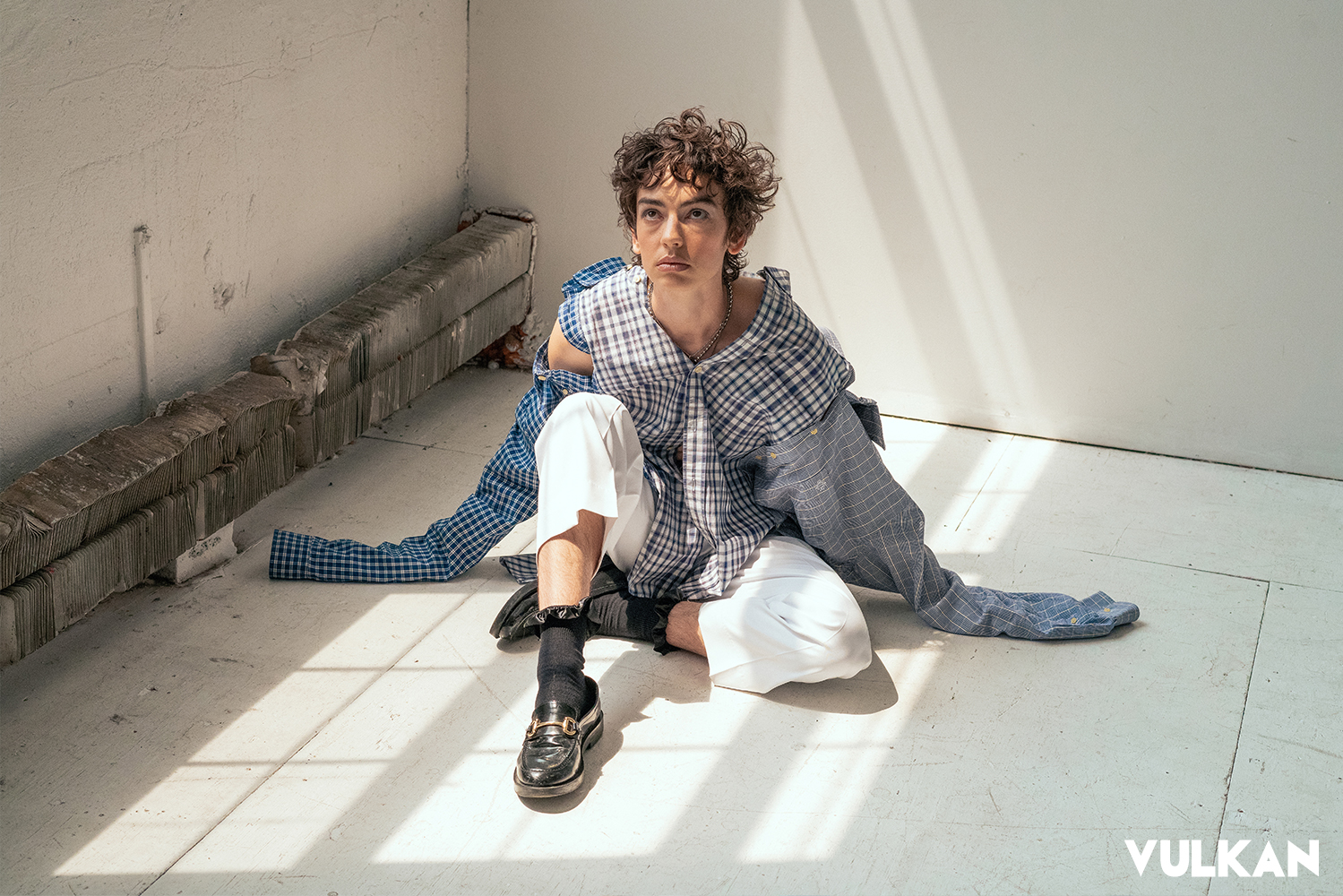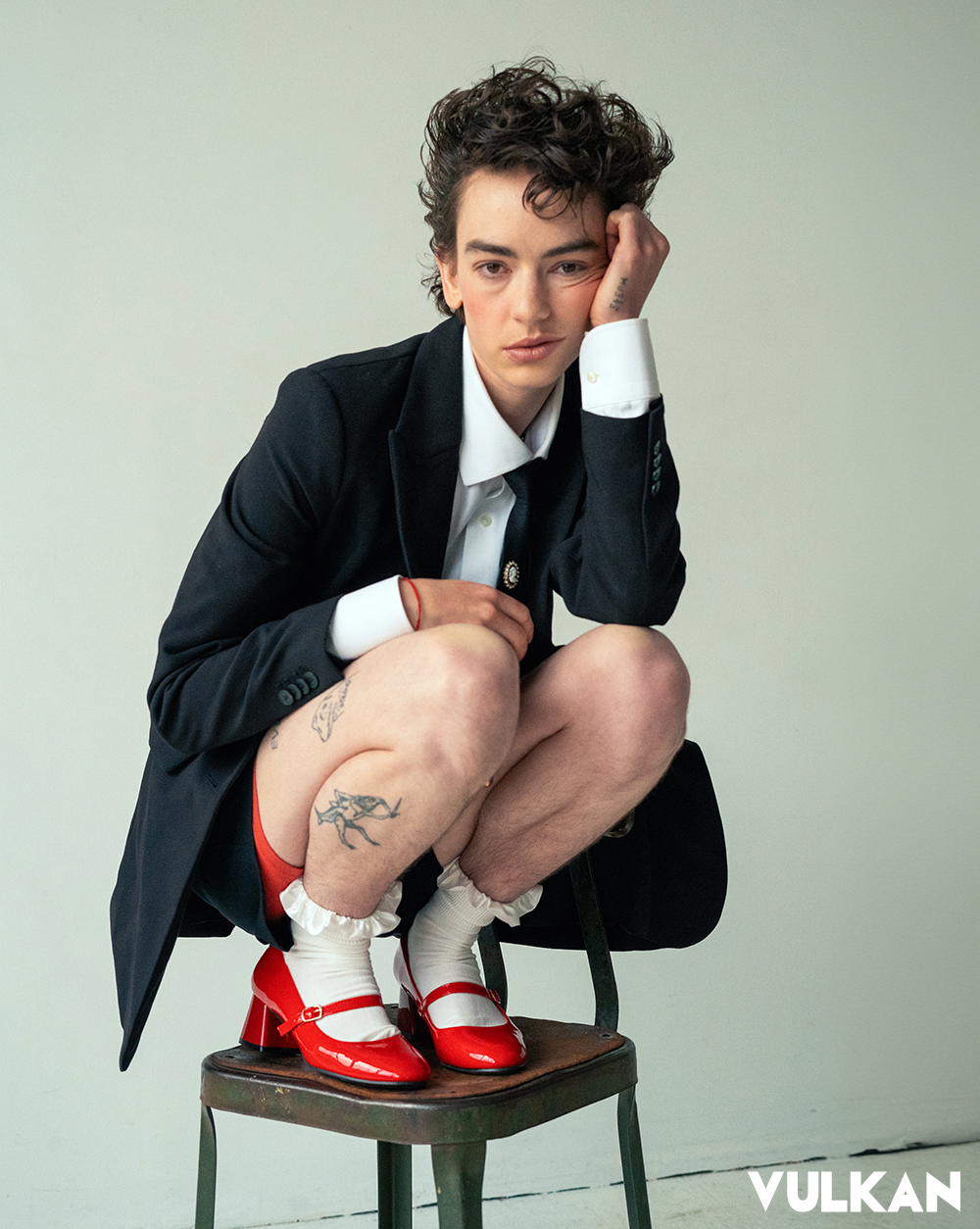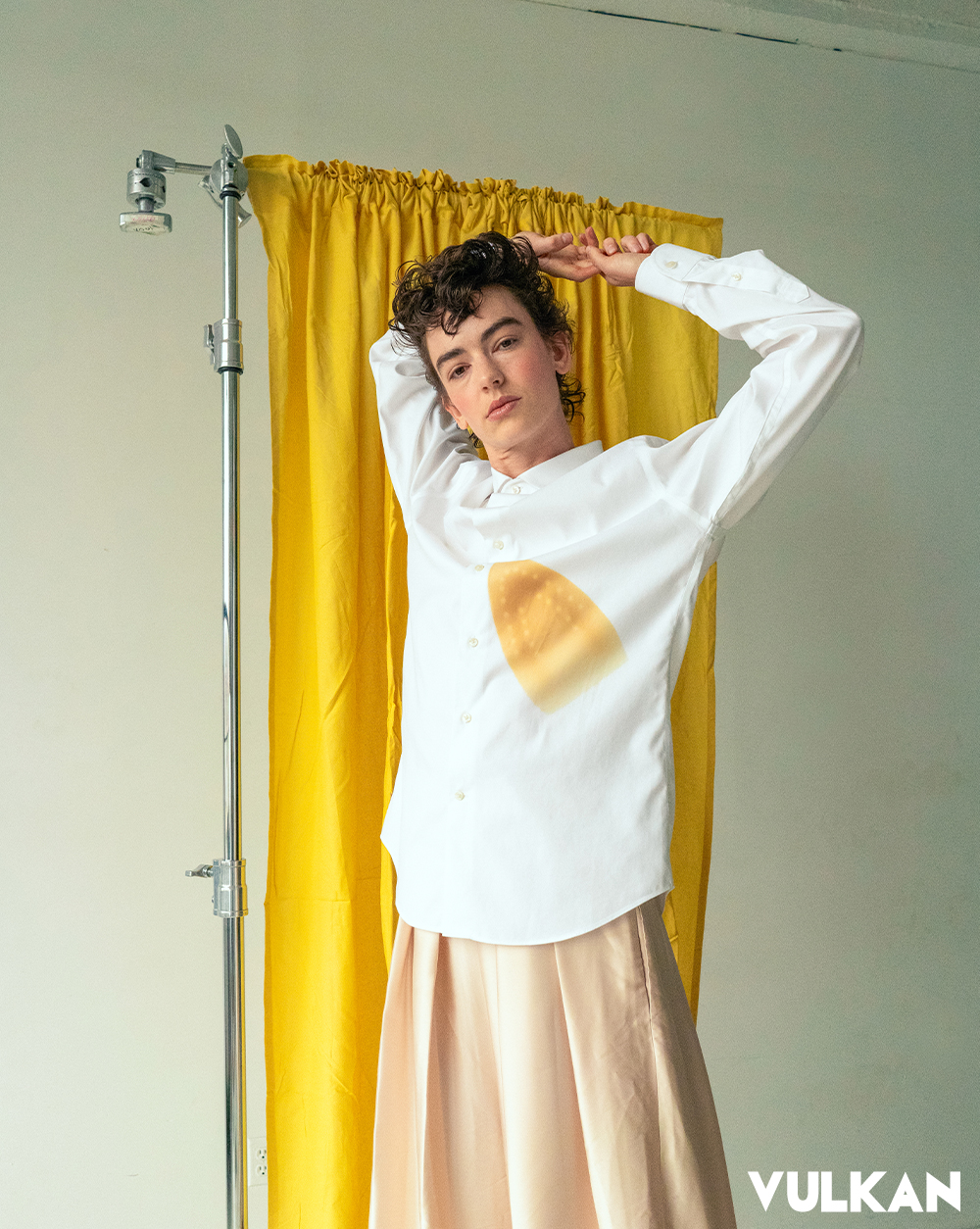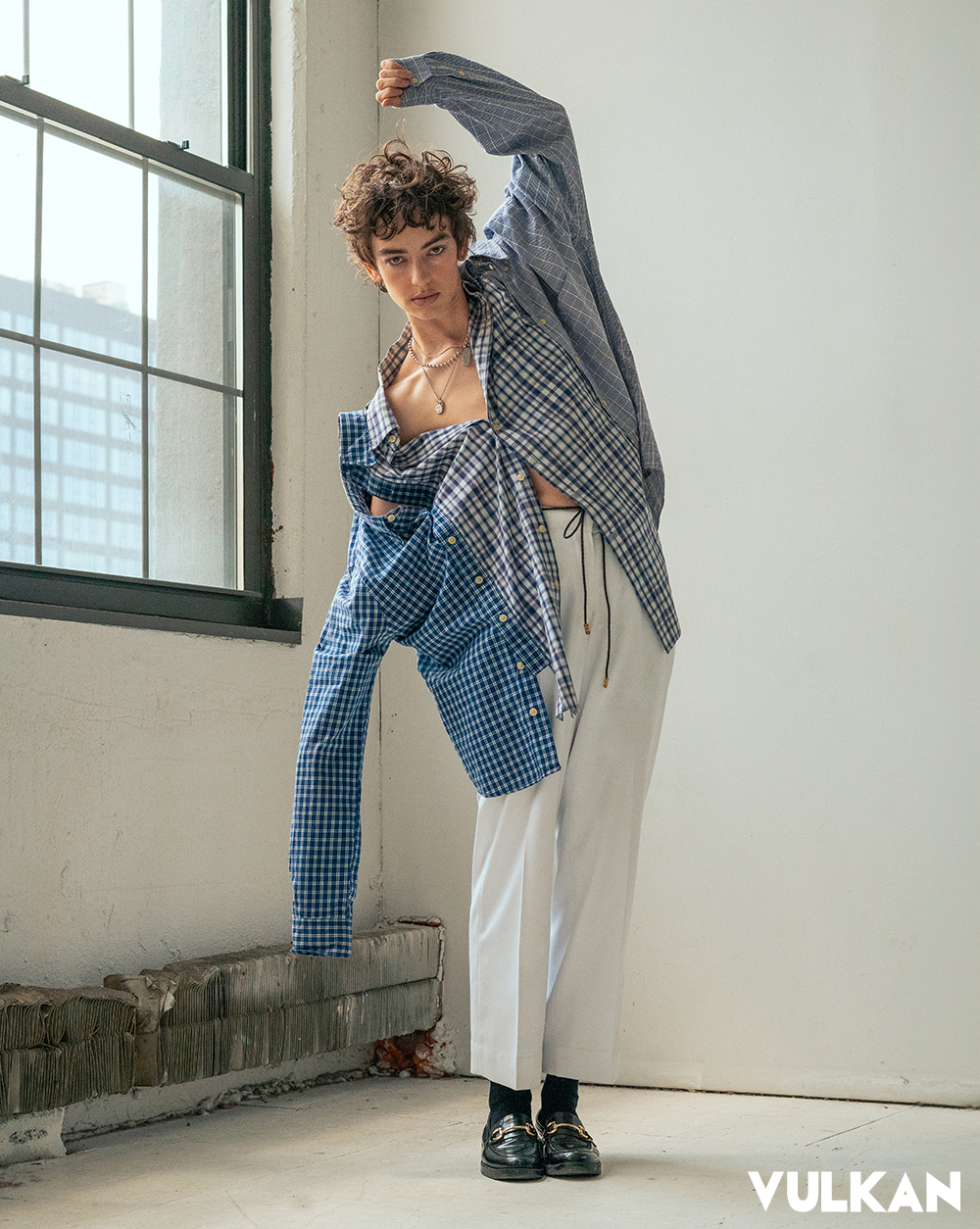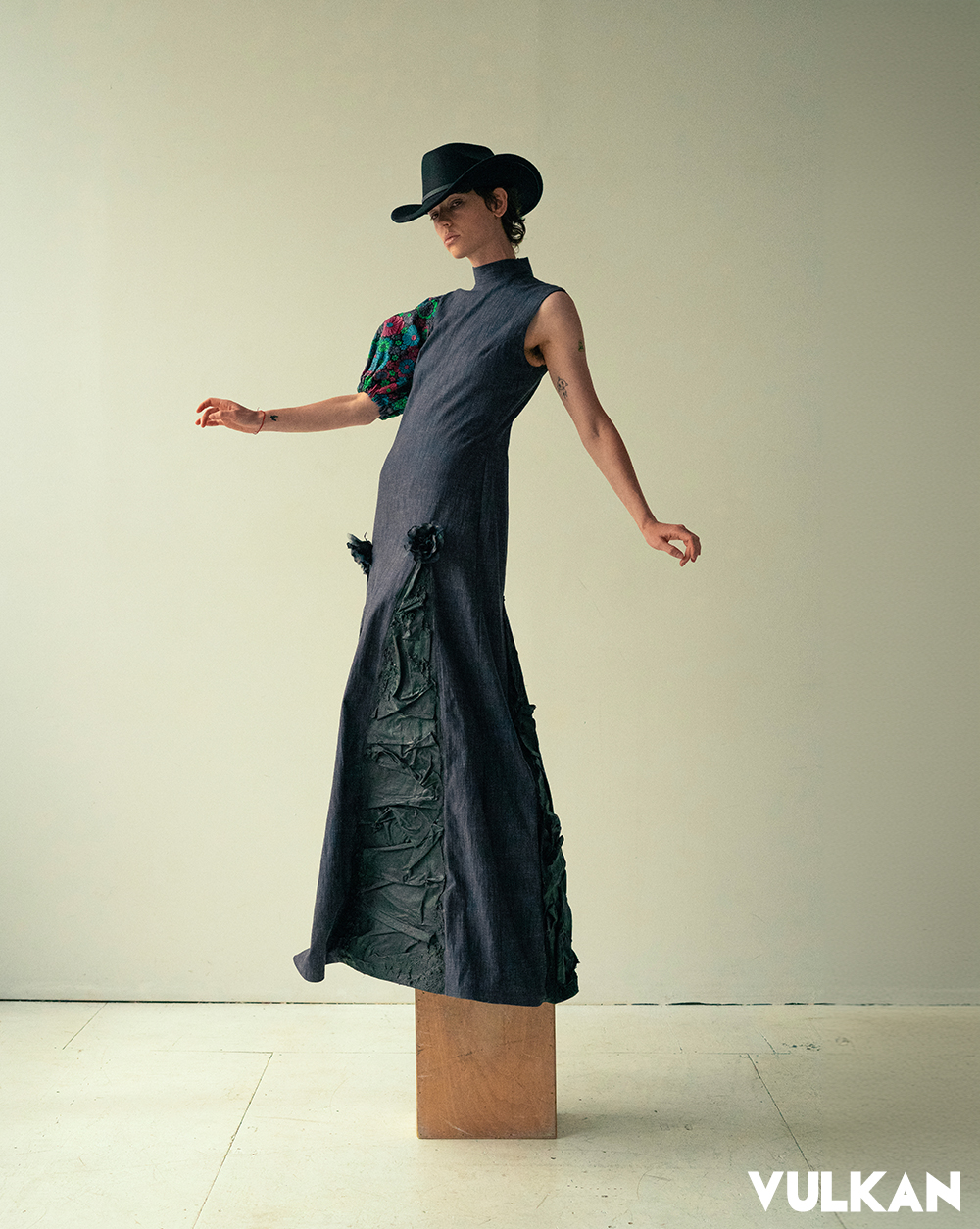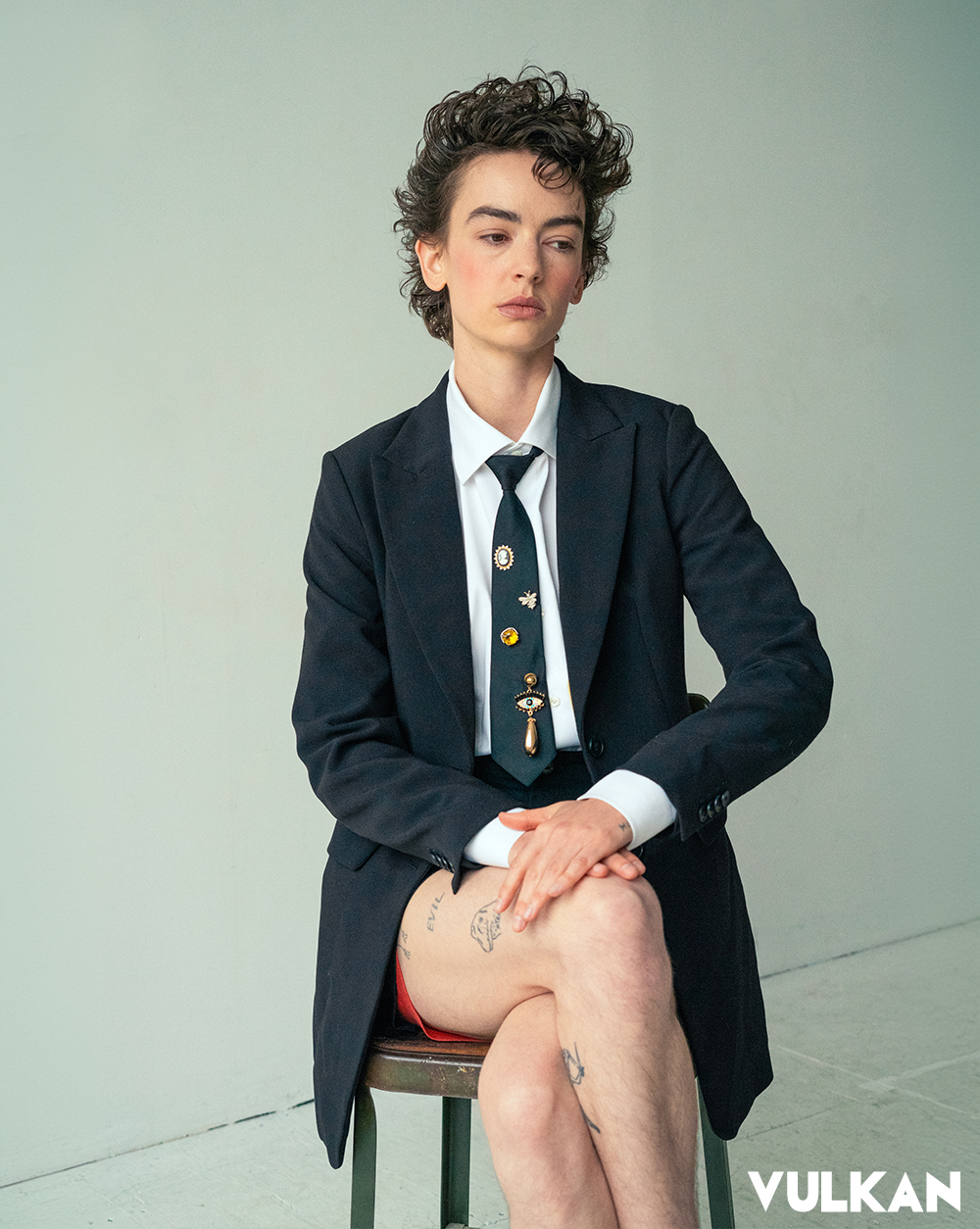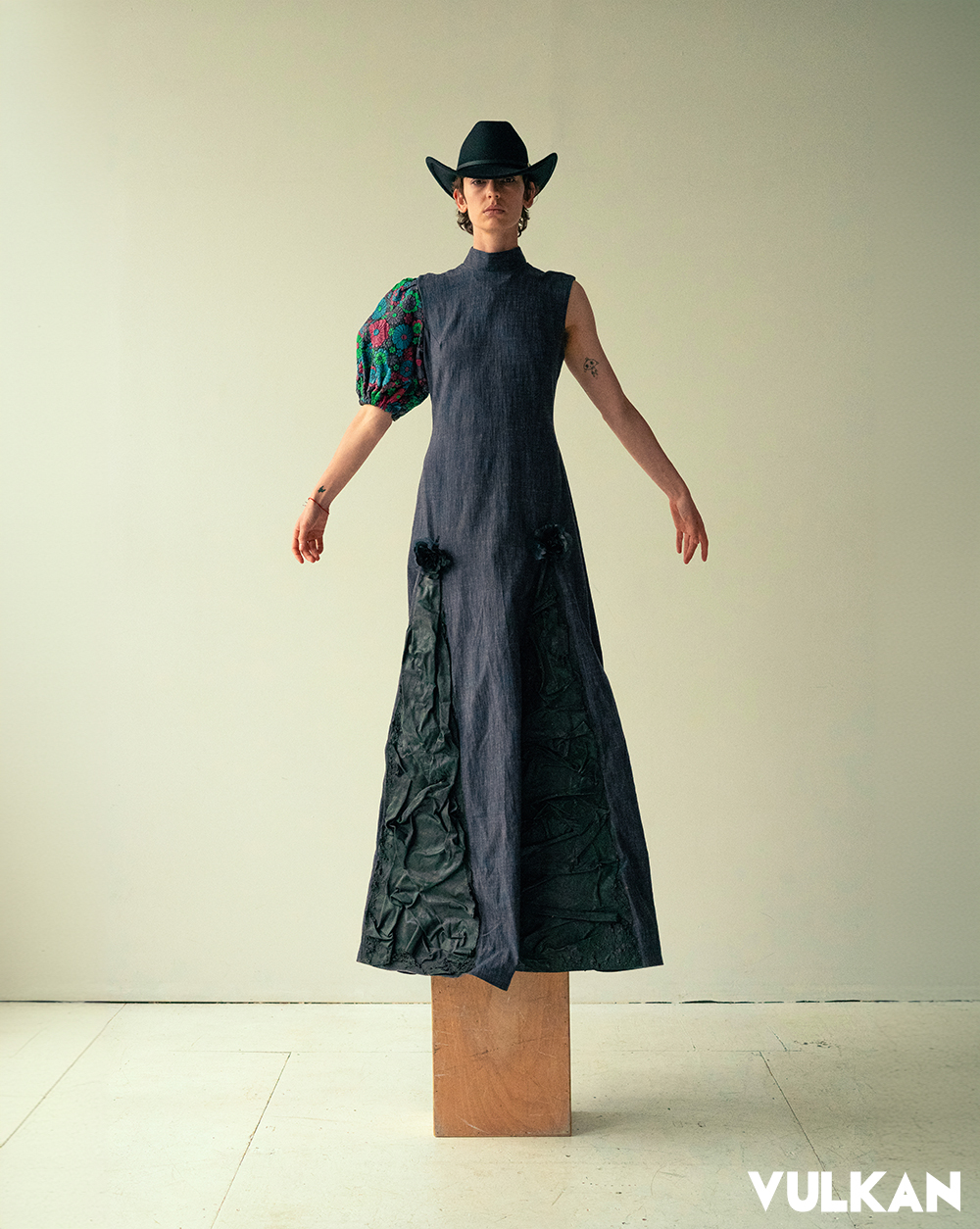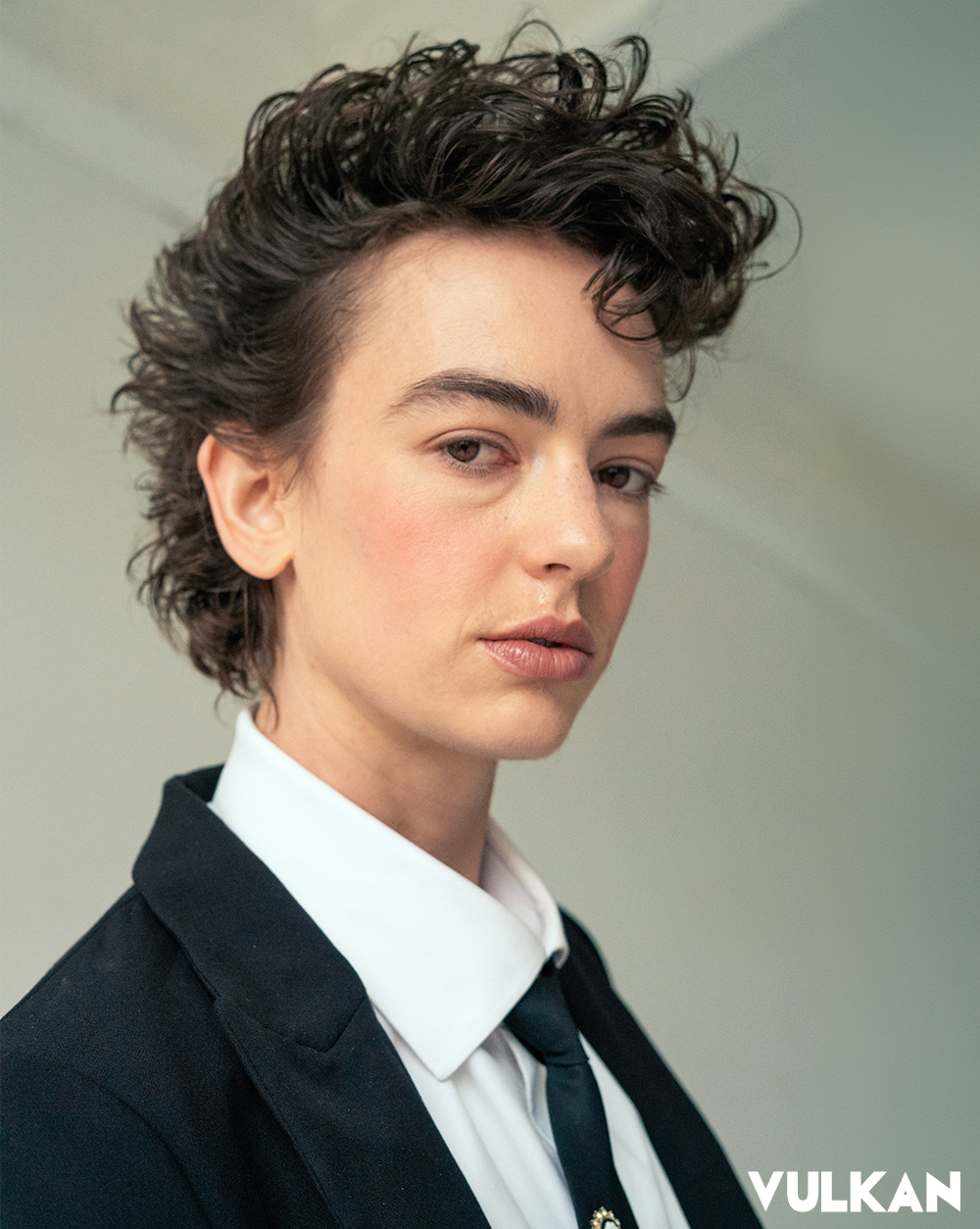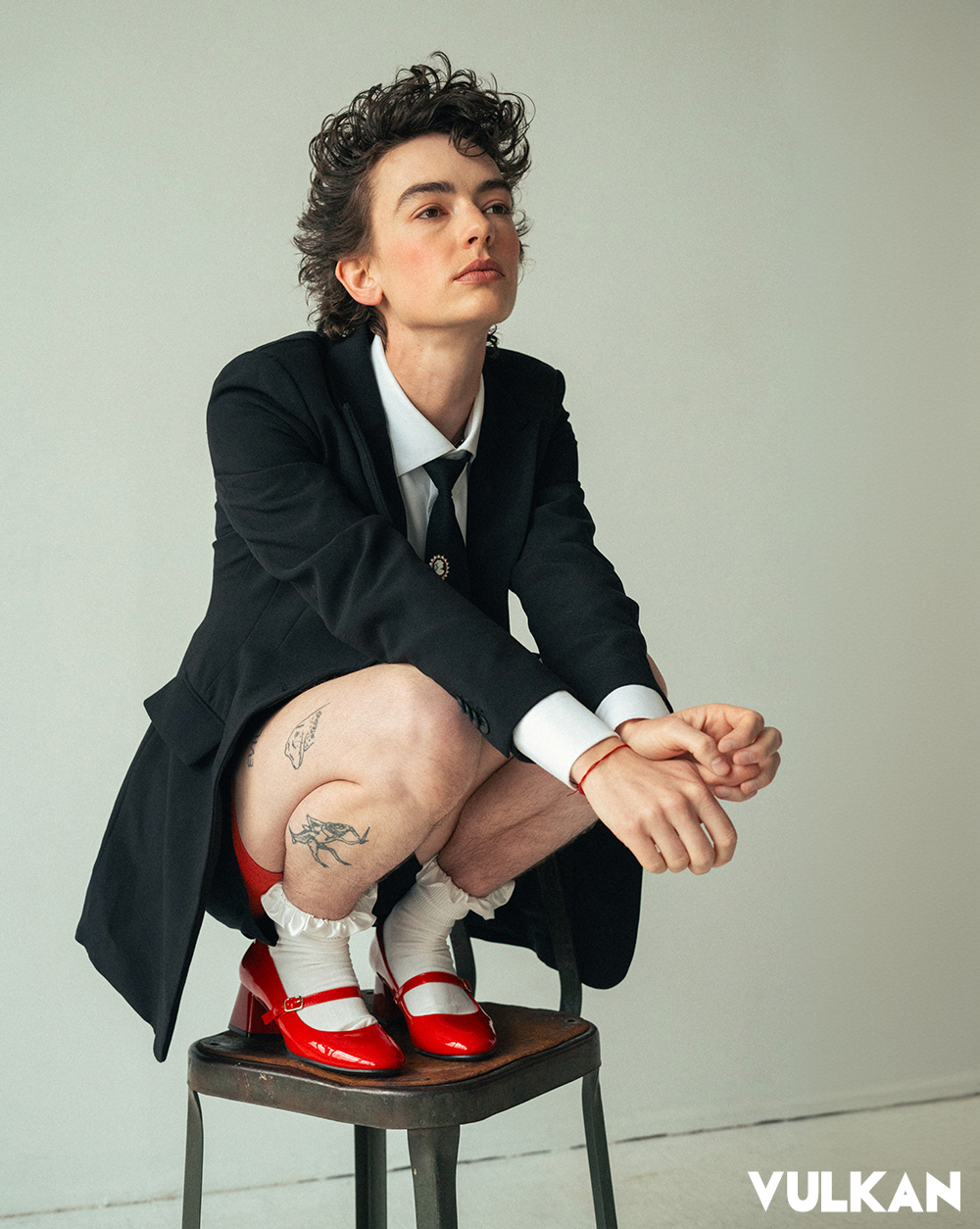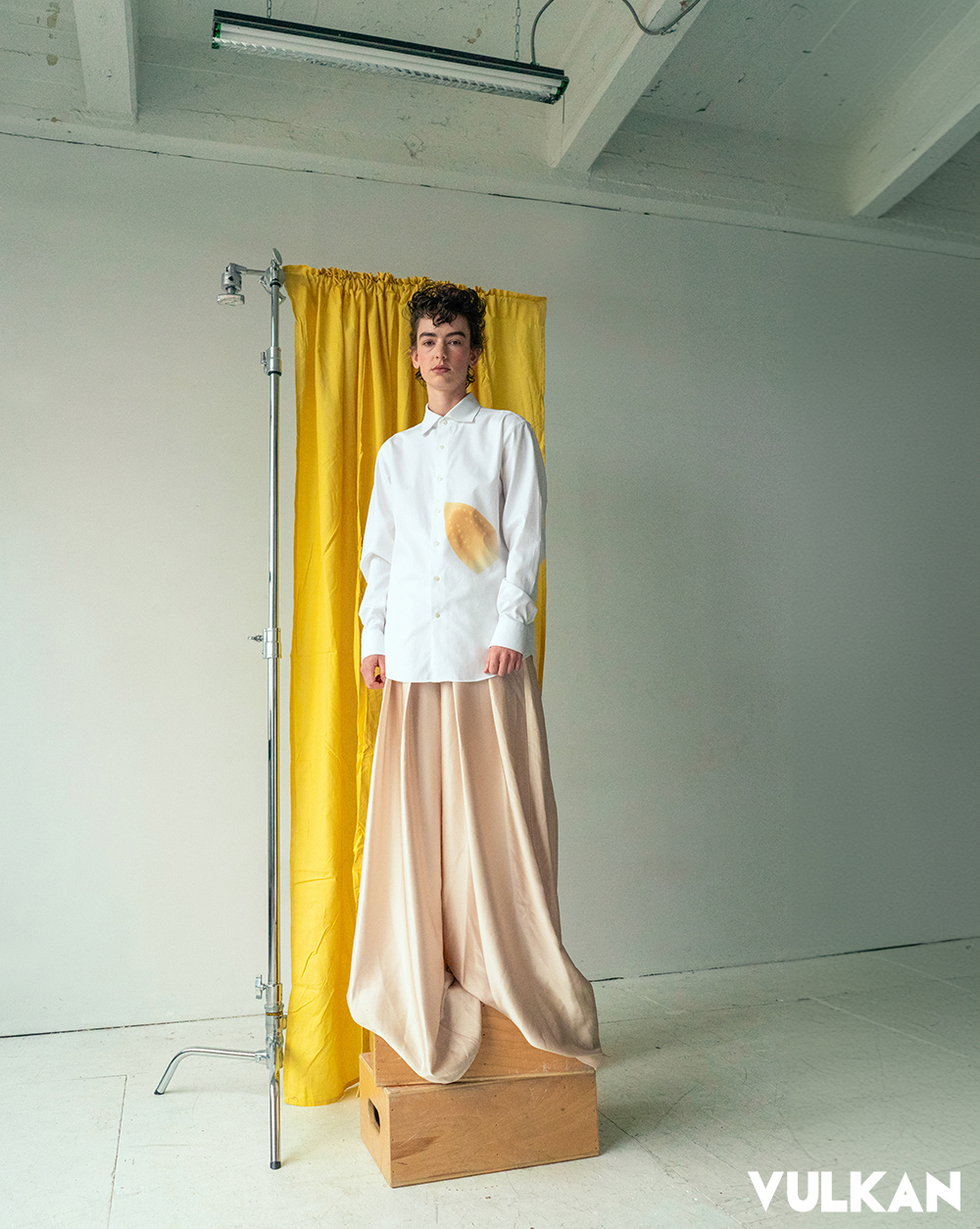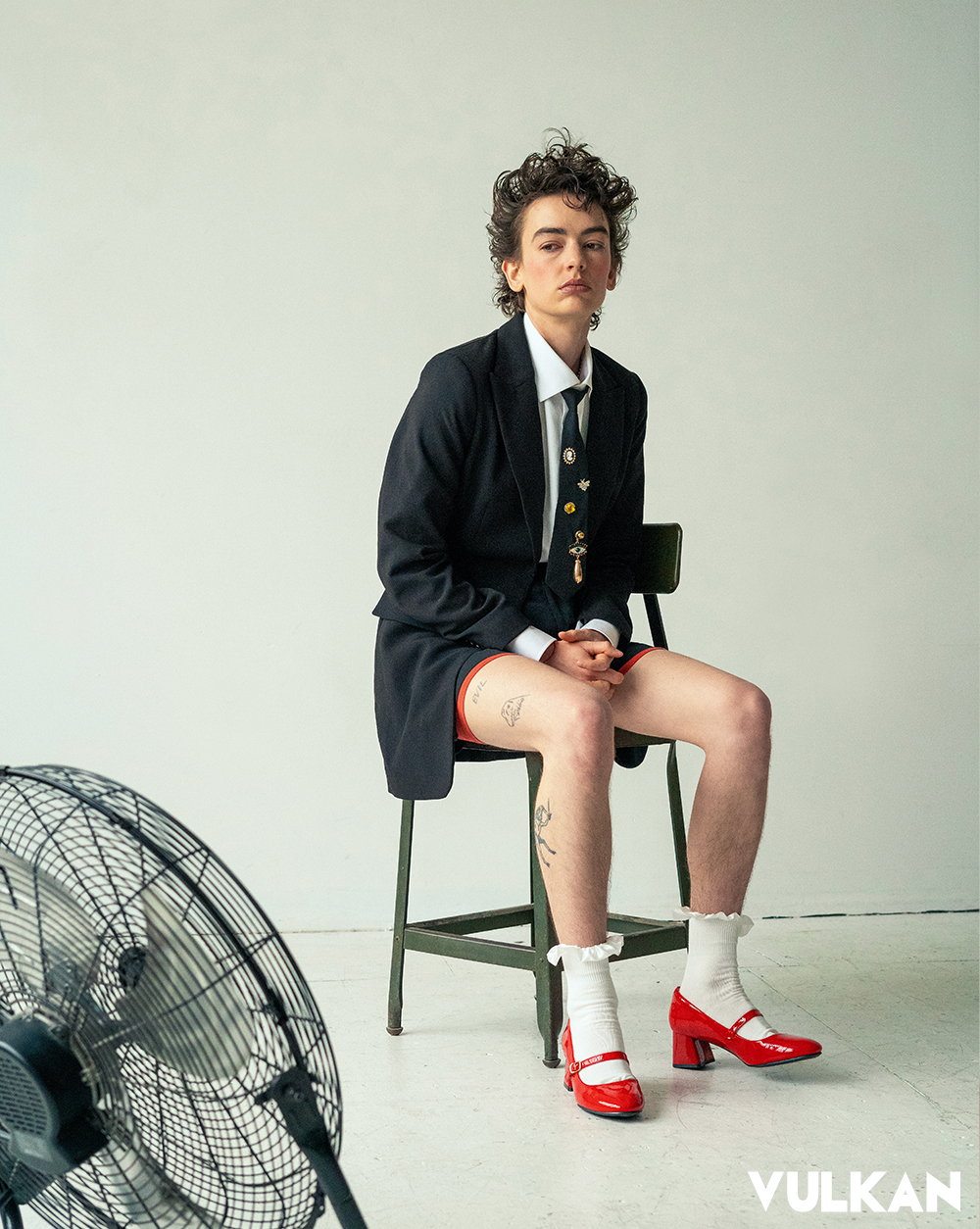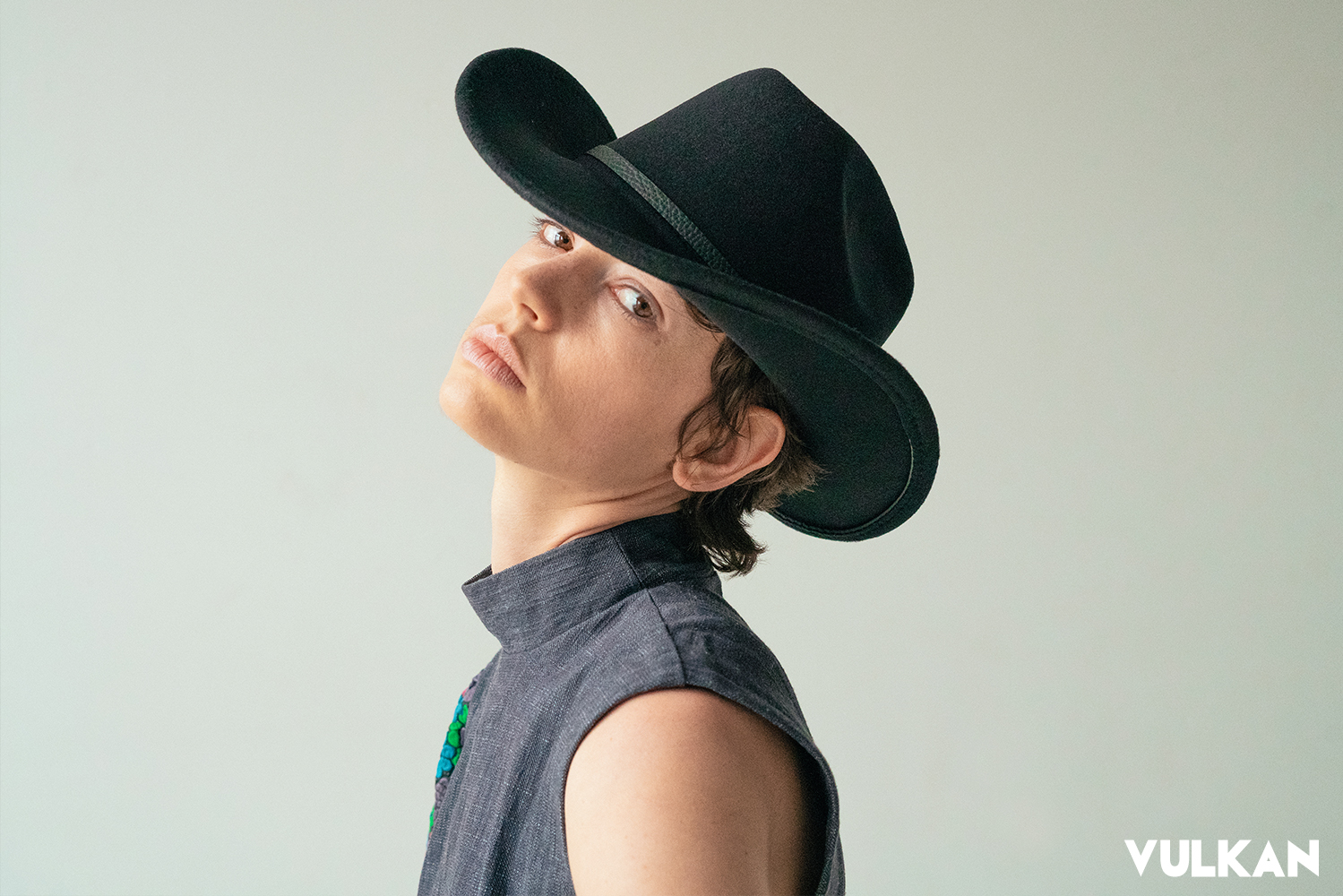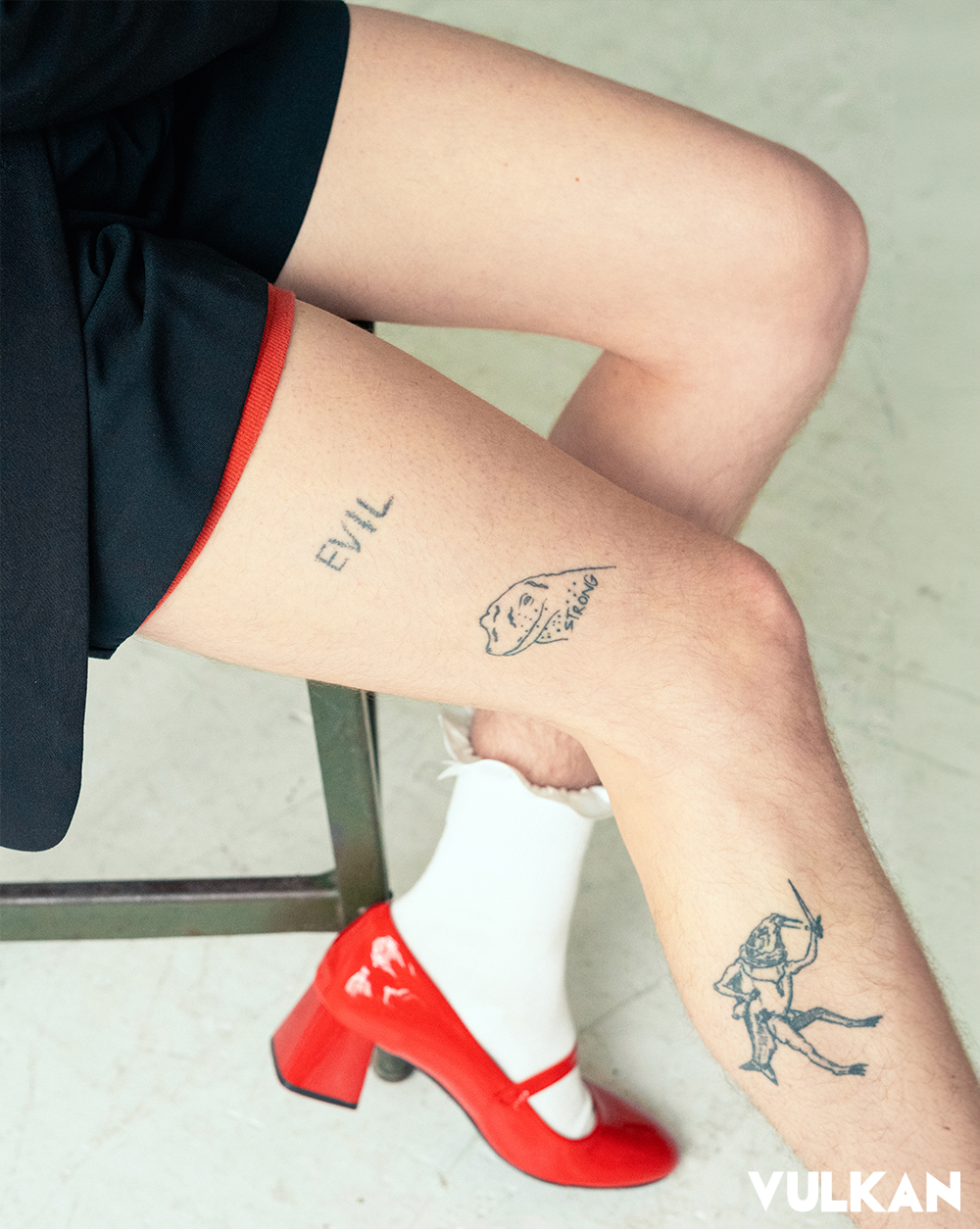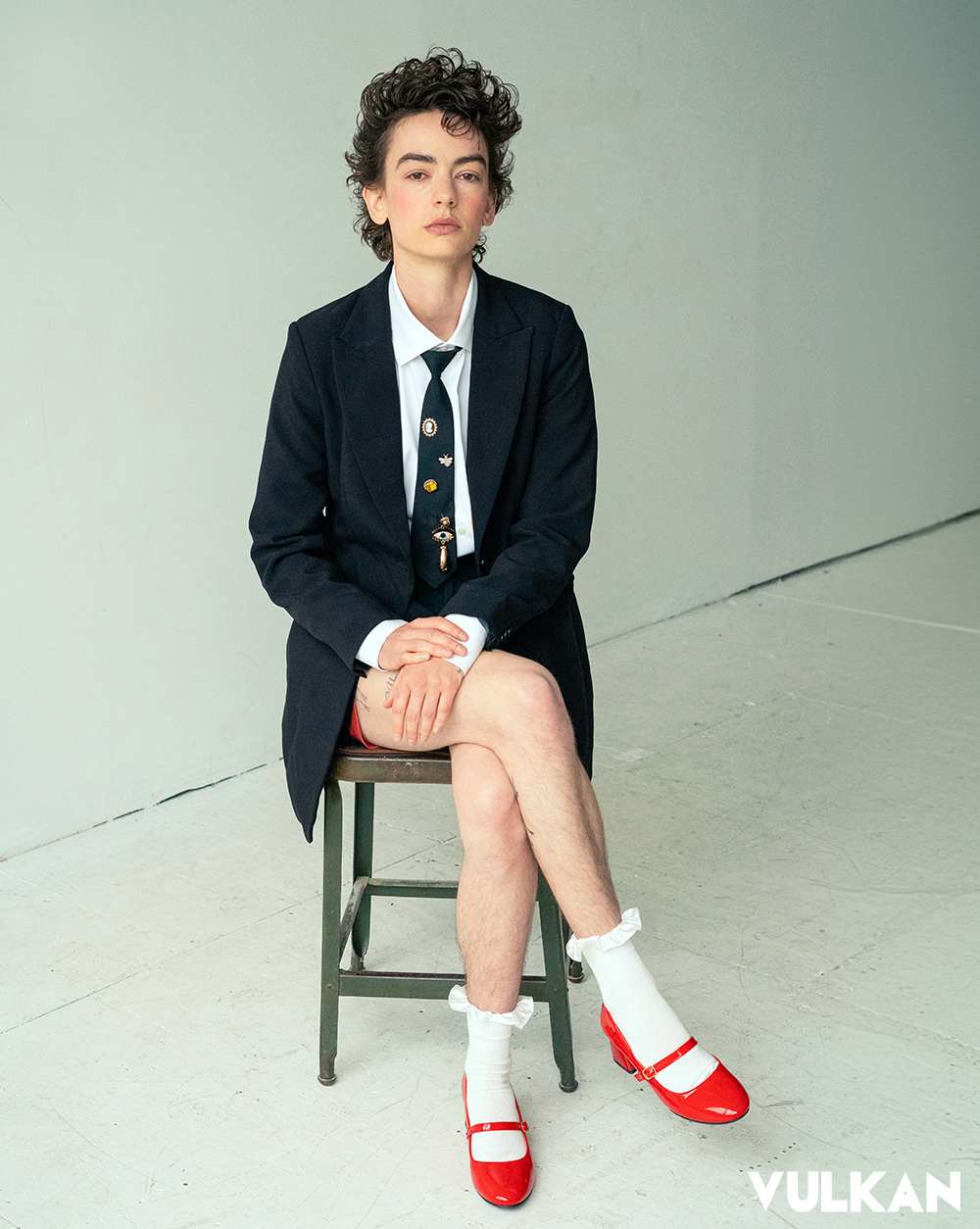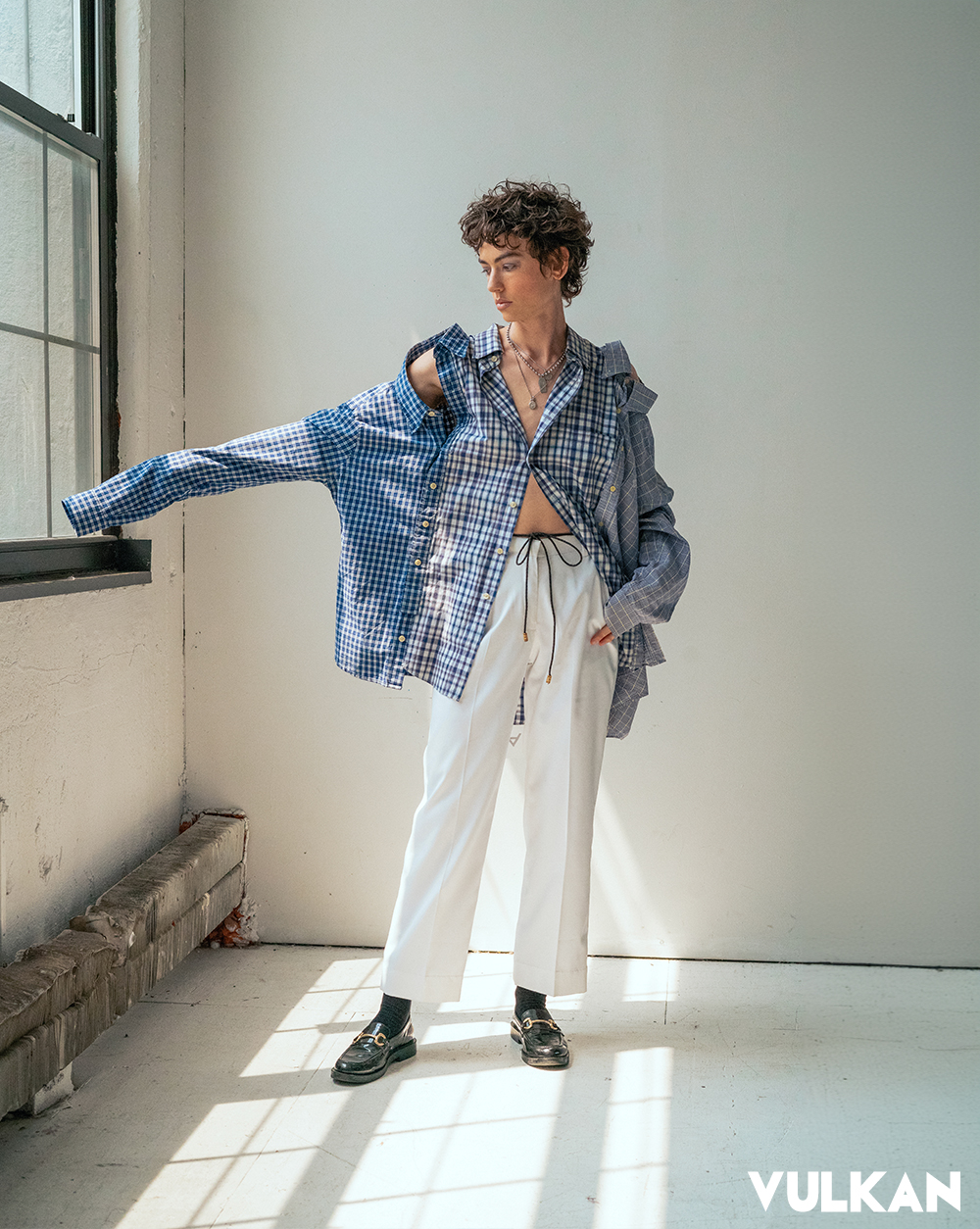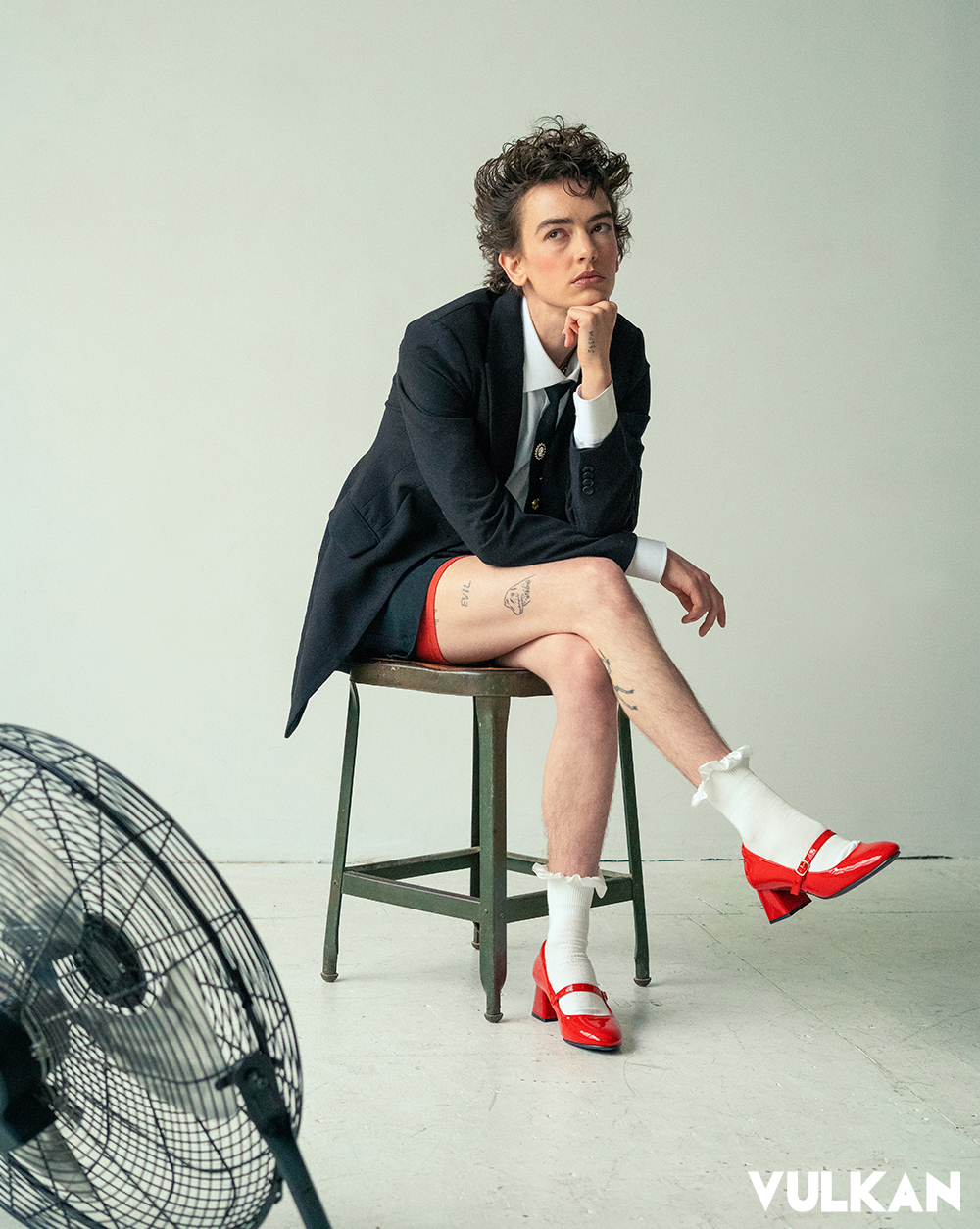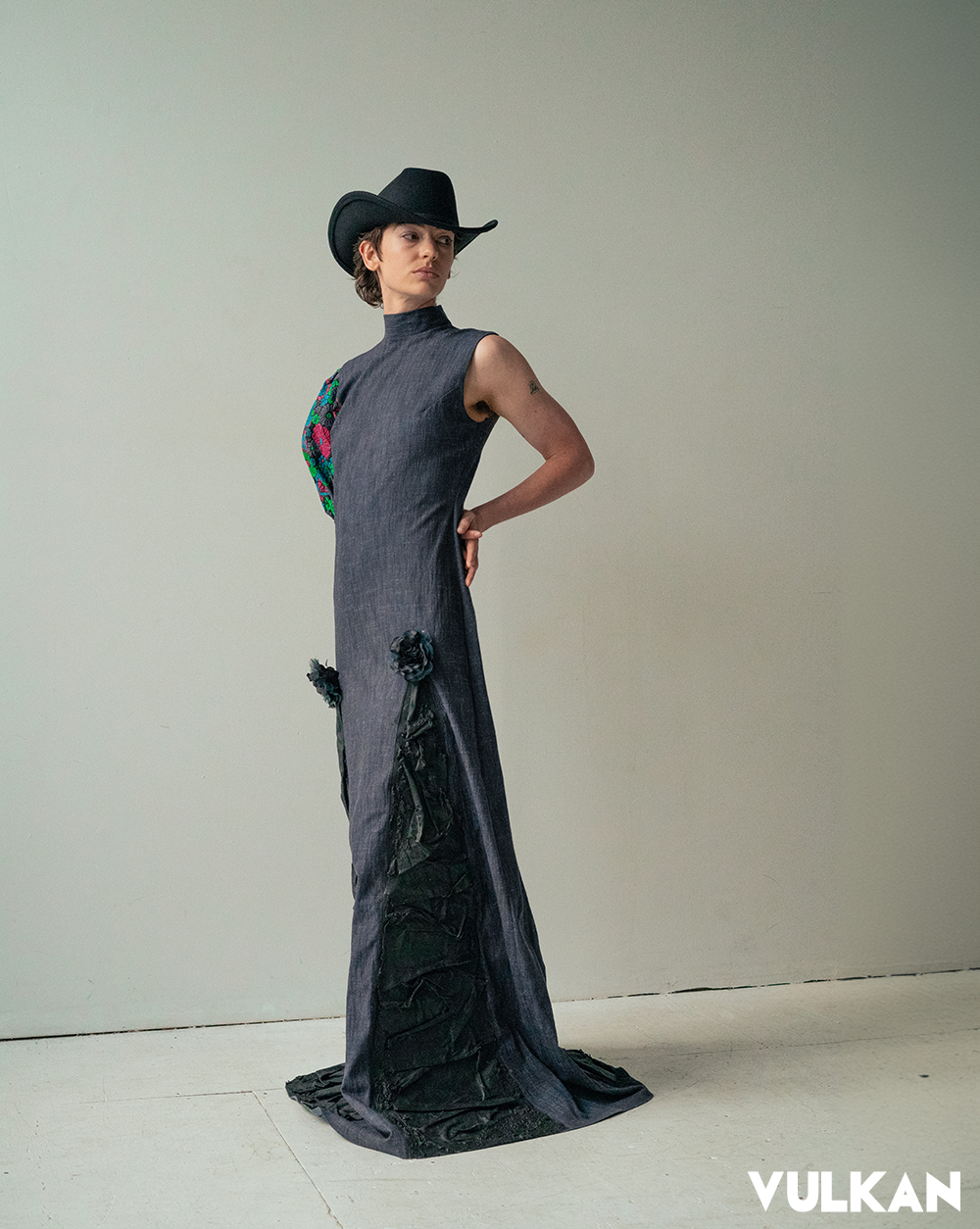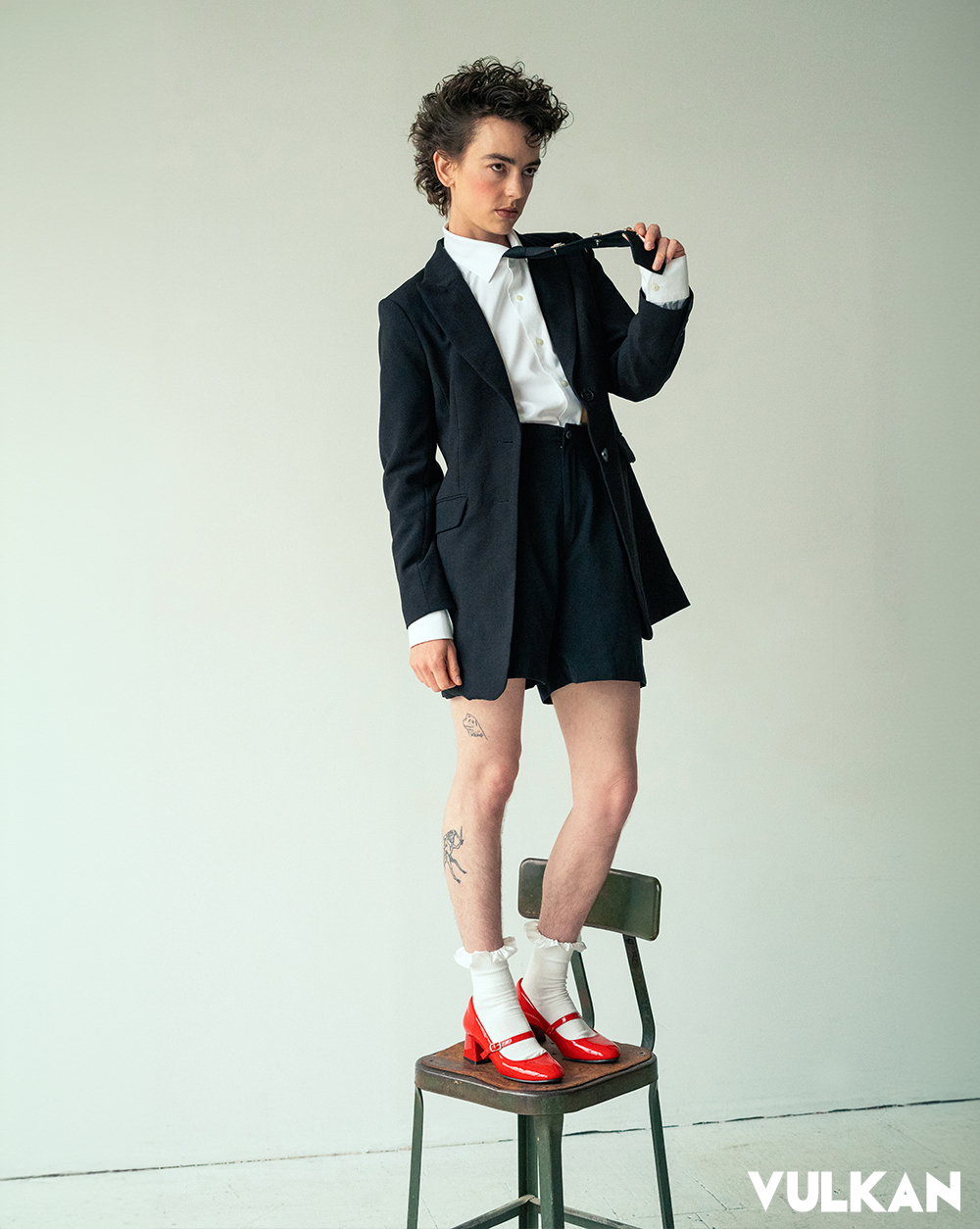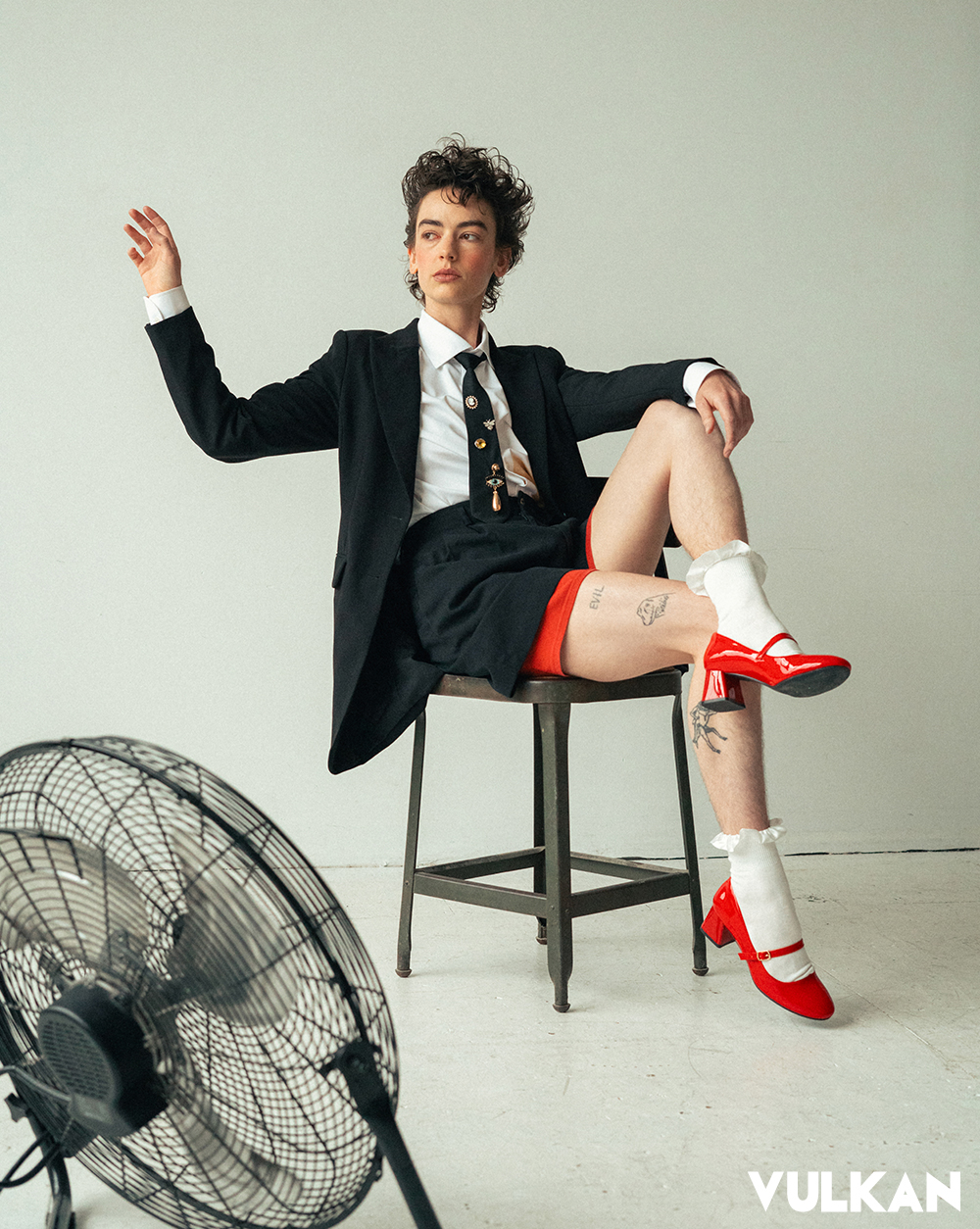VULKAN Luck Issue, print available July 31, 2024
In a world where authenticity and creativity often collide, Brigette Lundy-Paine stands out as a beacon of both. Known for their nuanced performances and compelling on-screen presence, Brigette has carved a niche in the entertainment industry, captivating audiences with their unique blend of talent and charm. From their breakout role in Atypical to their recent venture in I Saw The TV Glow, Brigette’s journey is a testament to their versatility and dedication to their craft.
In this exclusive interview with VULKAN Magazine, Brigette talks about their latest project, the intricacies of embodying a character through a transformative decade, and the deep bond shared with their co-star, actor Justice Smith. They also reflect on the evolution of media representation for gender nonconforming individuals and the invaluable role of close friendships in understanding one’s identity. The multi-talented performer offers an exclusive glimpse into her music project, a collaborative endeavor with an avant-garde fashion magazine, and her innovative film production company. Join us as we delve into the world of Brigette Lundy-Paine, exploring their artistic journey, personal growth, and idealizations for the future.
In the feature I Saw The TV Glow, your character forms a bond with the character Owen through their attraction to a 90s-coded late-night TV Show. Do you have any special memoirs from this decade’s television and movies?
I started a little bit later, but the first show I really loved was the OC. I was very attached to Seth and Ryan and Summer and Marissa. And so heartbroken when Marissa died. That was the first really emotional reaction I had to TV; I was just not able to believe that they would kill her, especially so soon. I also realized recently, I remembered that I watched Heroes, and that was another big TV show for me. And then Monk, starring Tony Shalhoub was a family staple.
Since the movie starts in 1996 and goes up to 2006, you interpret the transformation of Maddy throughout the whole decade. How was the process of embodying each phase of this turbulent journey from adolescence to young adulthood?
I wanted the three Maddys to feel very different. And so the youngest Maddy, I took a lot of inspiration from many of my friends, just kids in general, and sort of skater streetstyle from the late 90s. And young Maddy, I also listened to Cat Power a lot while preparing for her. So she was very emotionally vulnerable. And her movements were loose, almost like a puppy. And she knew she was protecting herself from something but she didn’t quite know what so there’s, there’s this sort of general defensiveness, but complete naivete and childlike wonder comes out when she talks about the Pink Opaque, and when she finds someone in young Owen who she can share this sacred love with. And then a second Maddie was very much inspired by Courtney Love and lesbian punk of the late 90s. And the reclamation of femininity is an attitude of “Fuck you. Stay away from me.” Rachel Dainer-Best was the costume designer. We worked to find this
kind of rough, feminine wardrobe that’s like these little tank tops and long skirts. And yeah, she’s just, she’s comfortable in herself, but only at the expense of despising everyone else. And then for the final Maddy, she’s not really from any specific period in time. I kind of imagined a Maddy that was the one I was most excited about. Originally, I imagined the oldest Maddie to be like, a creature that had emerged from the gutter almost like she’d crawled from another dimension. She was also very inspired by Matt Dillon in Rumble Fish and Harry Dean Stanton in Paris, Texas. These almost inaccessible cowboys with a story to tell. That style came again from Rachel. There are leather waist-up pants and white tank tops. Yes, it’s messy. It’s hard to touch the fashion from 2006 I can’t remember any real statements. It’s maybe… A lost decade? I mean, I was in sixth grade. But I think like that Maddie she’s not quite from 2006. She’s in the Pink Opaque, she’s Tara. So, she doesn’t exist in the time that the movie is set in any longer. She’s a creature from another dimension.
We experience a strong, beautiful bond between Owen and Maddy despite the timid presence of dialogues between them. Can you tell us any specific strategies you and actor Justice Smith created to develop such intimacy?
Yeah, Justice and I were pretty immediately connected. He has a very open and warm spirit. And so I felt genuinely comfortable around him right away. We’re both Leos we have a birthday one day apart. So, we got each other. And I think in one of the earliest scenes we did together, we ended up just singing songs from Dear Evan Hanson, at the top of our lungs, much to everyone else’s annoyance. But yeah, we brought out the theater kid inside of each other. But the relationship between Owen and Maddy on screen, I think, was more from Jane’s direction. She asked us to take a lot of time between our lines to each other. Especially in that bleachers scene, the first time you see them together. Jane asked that we almost not expect the other actor to respond. So we would say our line as if it was like, into the void. And then I would take a long time, then Justice would say his line. And so it was almost like we weren’t communicating on the same plane. There’s skepticism about each other’s existence. But ultimately it’s just trust, I think, in the dialogue as an independent entity. It’s like the first time Maddie smiles at him. She sees herself. Yes. Yes.
As someone who went through their teenage years in the 2000s, what are the differences you feel about how Gender nonconforming people are perceived and portrayed by the media these days?
I think it was just different. Now we have more language for what it means to be gender nonconforming. And when I was growing up, I remember, it was like a character on Degrassi who was trans-masc. Of course, cartoons were always a safe place for genderless or gender non-conforming characters, because you don’t have to follow the same standards. I’m thinking of Foster’s Home for Imaginary Friends, I loved that show growing up. And now I see it was because all those characters didn’t seem very gendered. Same with Sponge Bob. Now, there’s almost like a branding of genderless characterization on TV, which is problematic in its own way,
because it’s often, exploitive of certain… Certain identities without knowing much about them, or without actors being able to bring their own knowledge to characters. So I don’t know what it’s like to grow up now, but I think there are definitely more examples of how to be non-binary, I don’t know, ultimately, I think it’s just something that you might not ever be able to find in media because media is so binary, that you’ll just like, have to find in yourself. Like, in nature, I guess.
Getting a little back to the importance of friendship in the film, as a non-binary person, what do you think was the importance of your close friends in understanding your gender identity?
Well, all my close friends are people who have always understood me, probably better than I still understand myself. And people who have let me talk out how I’m feeling to them, even if they didn’t feel the same way. But most of my friends are artists. And I think a lot of my understanding of my identity comes through the work that we’ve done together. My closest friends, we had a band called Subtle Pride, for instance, and we would do these performances as hyper-feminized, Swedish popstars. And I would wear a long wig and be dressed with pieces entirely from Forever 21. And being able to perform femininity in that way, made me understand what it felt like to come home to my body a little more. And that was because of the environment that my friends and I created for each other to explore as artists. But I think also a lot of my friends are trans or queer. And there’s just, there’s an openness and a silliness, and a fearlessness in those communities. Because we’ve let go of a lot of the rigid thinking that defines straight or cis culture of friends, friendships in which certain people have to play certain roles. It just becomes a fluid expression of creativity or admiration for one another, which allows friendship, in my perception, to be a lot more free, and then you get to feel a lot more free.
Are there any characteristics of your Atypical character Casey you preserved for yourself from all those years of giving life to her?
Not so much. I mean, I think characters are always pieces of you. And I think you get to try on their personalities. So, the answer is probably not that I’m aware… I guess the only thing would be, I like to run a lot more because of Casey; I had to run a lot for that show. So now, when I run, I think about her.
You were born in an environment where your parents are actors and directors. Did this background ever function as an influence on your decision to become an actor yourself?
Oh, yeah, 100%, like, I wouldn’t be an actor if my parents weren’t actors. I was put in their place from the time I was literally like an infant. So yeah, I’m totally influenced by my parents. This is true to a point that I never thought really seriously about doing anything else. And I’m following in their footsteps in many ways, not just as an actor, but in a holistic sense. They had a theatre company when I was growing up. And I’ve got a magazine, a band, and now a Film Production company. And I see myself emulating their structures of community. You know, pouring all your money into your own projects in the ways that I learned from them. But yeah, definitely I think it was the family business.
How would you describe your own style changes from adolescence to young adulthood?
To be honest, I wore whatever was around. Like, I always had this obsession with graphic T-shirts, and hoodies because it felt like something I could never have. Like, I borrowed my friend’s softball hoodie at one point. It was an Alameda Girls Softball Association red hoodie, and I would wear it all the time. Just because I felt like it was so cool to wear a hoodie. And, then, one time somebody stopped me in the grocery store and was like “Oh, my God, you play softball!”, and I was like “No, I don’t…” I felt like such a poser. But then when I was older and I got to college, I think I was like trying out the boho chic. You know, long skirts, I worked at Urban Outfitters when I first moved to New York. And so I always shopped the sales section and be wearing the ugliest, like, yeah, like maxi skirts, which I fear are coming back. And like tube tops. And in that, I just started wearing baggy or more comfortable clothes. As for now, I’m still kind of coming out of a phase where all of my clothes I’ve found on the streets, or they were passed down from my roommate. So it’s sort of like, I guess, this old 20s clown. Like, I basically wear whatever I can find. But I really like blazers and trousers, and just like looking dapper, you know?
What would be your ideal artistic scenarios for the long term and near future?
Well, I’d like to produce and direct two films that we have. My friend, Alex McVicker, and I have a production company. We made a film called October Crowe, which we shot completely improvised. We’re going to take that on tour and then we’re going to produce two more films, Looking for Brookey, which is set in the West 1930s in New York, and then The Jalapeño Popper, which is a tap dance movie. And, we want to make those with some money, so we have to get some money. And then I want Wave magazine, I want people to find Wave. And I want people to understand themselves as Wave. The project of Wave magazine, we’ve run for six years. It’s an absurdist fashion magazine. And we’ve printed the last four issues, but it’s mainly online, you can follow us at Wave Magazine. And, Wave is… The earliest definition we could find is anything found without an owner. So it’s sort of this ideology where you play the piano even though you don’t know how; You make something without the intention of being bought or owned. And it’s completely self-made and collaborative and ridiculous-mentality. I’d like for waves to find us and for us to find waves.
Brigette Lundy-Paine @briiiiiiiiiig
Photography Bảo Ngô @baohngo
Styling Swanetta Hunt @swandion_ Assited by Luke Stage
MakeUp Cassandra Lee @cvsee
Hair Hiro + Mari @hiromarihair Video Aaron Zimmerman @vacation_aaron
Interview Anna Dória @annadoria._
Production Isabela Costa @isa.chromatic @maisonpriveepr_la + @bellomediagroup
